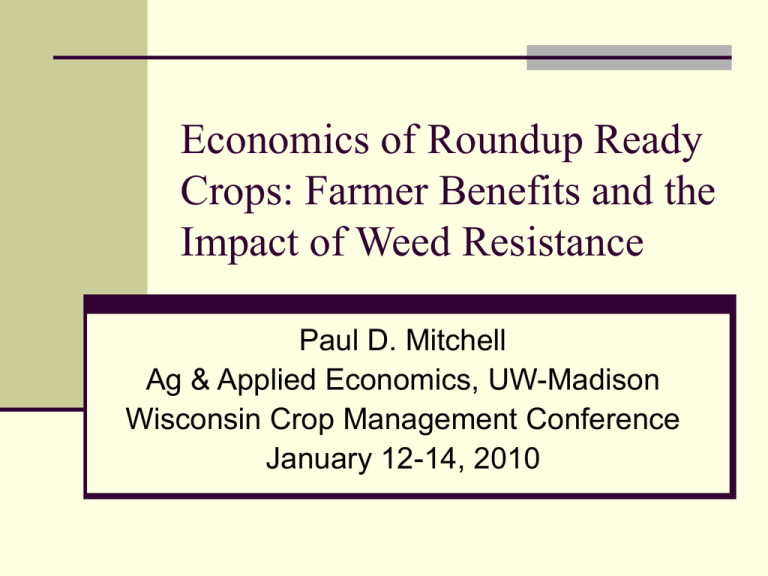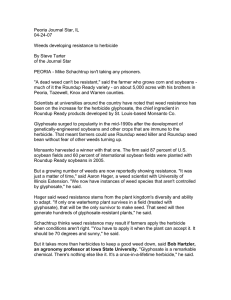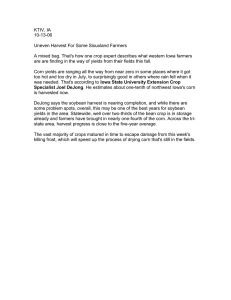Economics of Roundup Ready Crops: Farmer Benefits Impact of Weed Resistance (Power Point Jan 2010)
advertisement

Economics of Roundup Ready Crops: Farmer Benefits and the Impact of Weed Resistance Paul D. Mitchell Ag & Applied Economics, UW-Madison Wisconsin Crop Management Conference January 12-14, 2010 Herbicide Tolerant Crops Have Become Very Popular 91% in 2009 68% in 2009 Source: http://www.ers.usda.gov/data/biotechcrops/ Wisconsin Farmers Following the National Trend % Acres Planted in Transgenic Varieties 100 90 WI 85% in 2009 % Planted Acres 80 70 WI 64% in 2009 60 WI Soy WI Corn US Soy US Corn 50 40 30 20 10 0 2000 2002 2004 2006 Year Source: http://www.ers.usda.gov/data/biotechcrops/ 2008 2010 Weed Resistance: Clouds on the Horizon? Most of these herbicide tolerant crops are Roundup Ready Over reliance on a single herbicide/mode of action can lead to weed resistance/tolerance It’s happened for other herbicides and has happened for Roundup/glyphosate Global Distribution of Glyphosate Resistance Source: http://www.weedscience.org/glyphosate.gif Glyphosate Resistance is a Growing Problem in the US. Glyphosate Resistant Weed Species States with Glyphosate Resistant Weeds Number of weed species with glyphosate resistant populations and number of states with glyphosate-resistant weed populations (Source: Hurley, Mitchell & Frisvold 2009; Heap 2009). Weed Resistance is a Problem in Wisconsin, but not for Glyphosate HERBICIDE RESISTANT WEEDS IN WISCONSIN Weed Situation Herbicide Mode of Action Year Lambsquarters (Chenopodium album) corn C1/5 - Photosystem II inhibitors (atrazine) 1979 Smooth Pigweed (Amaranthus hybridus) corn C1/5 - Photosystem II inhibitors (atrazine) 1985 Kochia (Kochia scoparia) corn, railways C1/5 - Photosystem II inhibitors (atrazine) 1987 Velvetleaf (Abutilon theophrasti) corn C1/5 - Photosystem II inhibitors (atrazine) 1990 Giant Foxtail (Setaria faberi) carrot, corn, onion, sweet corn A/1 - ACCase inhibitors (fluazifop-P-butyl, sethoxydim) 1991 Large Crabgrass (Digitaria sanguinalis) carrot, onion A/1 - ACCase inhibitors (fluazifop-P-butyl, sethoxydim) 1992 Kochia (Kochia scoparia) roadsides B/2 - ALS inhibitors (sulfometuron-methyl) 1995 Common Waterhemp (Amaranthus rudis) soybean B/2 - ALS inhibitors (imazethapyr) 1999 Giant Foxtail (Setaria faberi) corn, soybean B/2 - ALS inhibitors (imazethapyr, nicosulfuron) 1999 Green Foxtail (Setaria viridis) corn, soybean B/2 - ALS inhibitors (imazamox) 1999 Eastern Black Nightshade (Solanum ptycanthum) soybean B/2 - ALS inhibitors (imazamox, imazethapyr) 1999 Source: Heap 2009 In Wisconsin, Glyphosate Resistance is not a Problem—At Least Not Yet! Chris Boerboom in summer 2009 started investigating giant ragweed in WI with suspected resistance to glyphosate WI Crop Manager June 18, 2009 (http://ipcm.wisc.edu/Default.aspx?tabid=53) David Stoltenberg continuing the research Seeds from plants surviving glyphosate applications being prepped (cleaned and cold treated) for greenhouse experiments taking place late this winter Stay tuned for details Questions Addressed in This Study What is the value of the benefits to farmers from RR Soybeans & RR corn? Do farmers think weed resistance is a problem? How does weed resistance affect the value of RR soybeans & RR corn? Overview the Study and Summarize Results Study of RR Benefits and Resistance Terry Hurley (U of MN), Paul Mitchell, and George Frisvold (U of AZ) Corn, soybean and cotton growers Telephone survey of 400 corn, 400 soybean and 400 cotton famers from main states At least 250 acres of target crop Surveyed during Nov-Dec 2007 Questions on 2007 and plans for 2008 Weed management with RR focus Funded by Monsanto Where are the Corn farmers from? 25 from WI 1 2 >2 Where are the Soybean farmers from? None from WI 1 2 >2 Farmer Concerns about Resistance No where in the survey was weed resistance ever mentioned End of survey asked an opened question “What are your biggest concerns in regards to weed management?” Responses mentioning weed resistance Concerned about weed resistance 47% corn growers, 52% soybean growers Mentioned having weed resistance 3% of all growers (corn, cotton, soybean) Concerned about weed resistance 0% > 0% to 50% > 50% Mentioned having weed resistance 0% > 0% to 50% > 50% Number of weed species with suspected or confirmed resistance to glyphosate in 2006 1 2 3 Source: Monsanto Estimating Farmer Benefits Farmers asked their planned 2008 RR and conventional corn/soybean acres and RR corn/soybean acres with a residual herbicide How will these acreages change if the price of RR seed changed or the price of residual herbicide changed a few dollars per acre From acreage shifts to (hypothetical) price changes, derive value of RR crop using “consumer surplus” “Contextually stated preferences” Farmers give more reasonable results than just asking them directly: “What’s RR corn/soybeans worth to you?” Telephone Survey Script For the next few questions, please think about how your current plans for the 2008 season might change if your cost for Roundup Ready [crop] seed increased by [$] per acre. 22a. If the cost for Roundup Ready [crop] seed increased by [$] per acre, would you plan to plant Roundup Ready [crop] next year in 2008? 22b. [If “yes” in Q.22a >> ask:] How many acres of Roundup Ready [crop] would you plan to plant next year? Remember, you earlier indicated that you currently plan to plant [Q.17] acres of Roundup Ready [crop] in 2008. 22c. [If RR less than 100% of crop acres >> ask:] And, given this price change, how many acres of conventional herbicide [crop] would you plan to plant in 2008? That is, [crop] that is not Roundup Ready or LibertyLink or AgriSure? Consumer Surplus A D$2/ac Seed Price Area A + B = ½ x 250 x 10 = $1250 or $5/ac Reported acreage at hypothetical higher price B Current acreage at current price D50 ac RR Acres 250 acres Area A + B is “Consumer Surplus” Dollar value a farmer gets from RR crop What is the value ($/ac) of the benefits to farmers from RR Soybeans & RR corn? Corn Median Benefit $16.74 w/ residual Soybean $11.93 90% Conf. $11.44 to $8.97 to Interval $32.34 $17.39 Effect of –$4.81 (–29%) Residual Herbicide w/ residual $8.44 $5.29 $7.47 to $9.77 $4.02 to $7.41 –$3.15 (–37%) Farmers find RR crops valuable, even if used with a residual Using a residual decreases value of RR crops about 30%-40% How does weed resistance affect the value of RR soybeans & RR corn? Used growers’ responses to open ended questions to code whether they are concerned about resistance Used Monsanto data to see if farmed in a county or a crop reporting district (CRD) with confirmed resistance % Change in Value of RR Crop Resistance Corn w/ residual Soybean Concerned 3.1% 0.3% 3.9% 25.2% In County –0.4% –0.4% –0.7% 4.8% In CRD –0.5% 0.5% 1.8% –9.1% Red values significant at the 10% level w/ residual How does weed resistance affect the value of RR soybeans & RR corn? Weed resistance and concerns about weed resistance do not seem to affect the value of RR corn Farmers already commonly use multiple herbicides, so they have options they are used to using Farmers concerned about weed resistance find RR soybeans more valuable than farmers not concerned about weed resistance, especially if they are using RR soybeans with a residual Proactively managing resistance is easier with RR soybeans, making RR soybeans more valuable Soybean farmers in regions with weed resistance find using RR soybeans with a residual less valuable Value of RR crop reduced if “forced” to use a residual because of local development of resistance by others Farmer Use of Multiple Herbicides with different MOA by crop Use Multiple Herbicides with Different Modes of Action 400 300 Don't know Never 200 Rarely Sometimes Often Always 100 0 Corn Soybean Cotton Corn farmers most likely to follow this practice Soybean farmers least likely to follow this practice Summary of Findings Farmers are concerned about herbicide resistance: ~ 50% RR crops are valuable, even if used with a residual Using a residual decreases value of RR crops about 30%40%, but still substantial have value ($8 to &17/ac) Weed resistance & concerns about weed resistance Seem not to affect the value of RR corn RR soybeans more valuable if concerned about weed resistance, especially if using a residual In regions with weed resistance, using RR soybeans with a residual is less valuable Recommendation: encourage farmers to adopt weed resistance management BMPs Weed Resistance BMPs Scout fields before a herbicide application Scout fields after a herbicide application Start with a clean field, using a burndown herbicide application or tillage Control weeds early when they are relatively small Control weed escapes and prevent weeds from setting seeds Clean equipment before moving between fields to minimize weed seed spread Use new commercial seed that is as free from weed seed as possible Use multiple herbicides with different modes of action during cropping season Use tillage to supplement weed control provided by herbicide applications Use the recommended application rate from the herbicide label Source: http://www.weedresistancemanagement.com/stewardship.html (Monsanto) Chris Boerboom’s White Paper Rotate between Roundup Ready and conventional crops or crops with other types of herbicide resistance. Use Roundup Ready crops in your rotation where they have the greatest economic and management value. Rotate glyphosate with other herbicide modes of action. Rotate non-glyphosate herbicides over time as well. Apply glyphosate at labeled rates at the correct stage of growth. If glyphosate is used as a burndown treatment and in-crop, tank mix the burndown treatment with another mode of action. Use cultivation after in-crop applications of glyphosate when possible. Scout fields regularly and identify weeds present. Respond quickly to changes in weed population. Source: http://128.104.239.6/uw_weeds/extension/glyphosate%20white%20paper.pdf Boerboom’s examples of crop and herbicide rotations that promote glyphosate stewardship Tilled Corn/Soy No-Till Corn/Soy Alfalfa/Corn Continuous Corn Conventional Corn YEAR 1 Herbicides w/ nonglyphosate MOA Conventional Corn Alfalfa Burndown: 2,4-D + Glyphosate + 2,4-D glyphosate. In-crop: in early fall herbicides w/ nonglyphosate MOA Conventional Corn Herbicides w/ nonglyphosate MOA RR Soybean YEAR 2 Glyphosate early postemergence RR Soybean RR Corn Burndown: 2,4-D + Glyphosate early glyphosate. In-crop: postemergence* glyphosate early Cultivate postemergence RR Corn Plant only for specific weed problems Glyphosate early postemergence* Cultivate YEAR 3 Repeat rotation Repeat rotation Repeat rotation Conventional Corn Herbicides w/ non glyphosate MOA YEAR 4 Alfalfa Source: Chris Boerboom’s White Paper Questions? Paul D. Mitchell UW-Madison Ag & Applied Economics Office: (608) 265-6514 Cell: (608) 320-1162 Email: pdmitchell@wisc.edu Extension Web Page: www.aae.wisc.edu/mitchell/extension.htm




